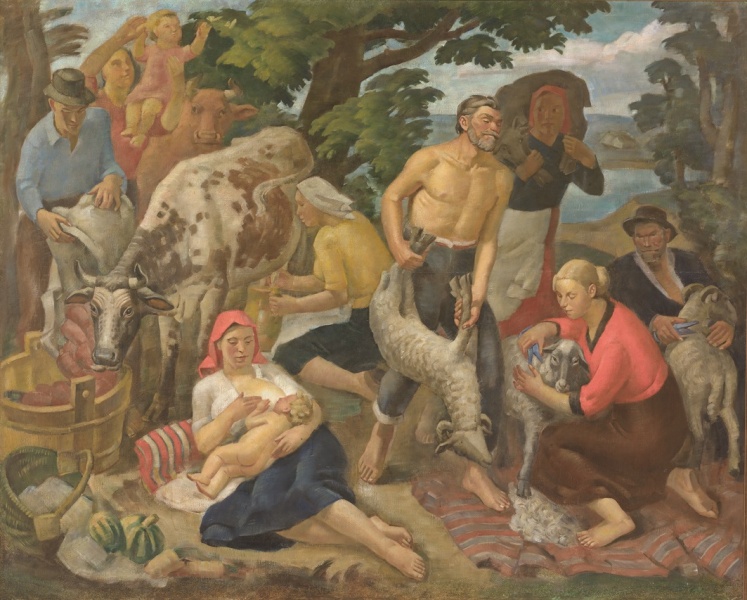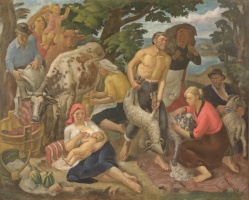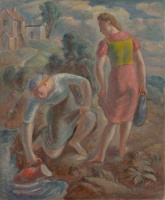

Composition (graduation work from the Faculty of Art at Stephen Bathory University)
| Author: |
Koźma Czuryło (1908–1951)  |
| Created: | 1936 |
| Material: | canvas |
| Technique: | oil |
| Dimensions: | 148 × 226 cm |
| Signature: | unsigned |
The artist was born and grew up near Nesvizh, and is recorded as a student at Stephen Batory University under the name of Koźma Czuryło when he studied in the Department of Art from 1929 to 1936. His contemporaries remember him and another student, Lew Dobrzyński, who was also of Byelorussian origin, as the most talented students of Ludomir Sleńdziński and Jerzy Hoppen. He was considered to be a true representative of the school of Vilnius Neo-Classicism, although he only visited Italy, the homeland of the new Classicism, in 1937, under both happy and sad circumstances. That year, he married Wanda, the sister of his peer Idelfons Houwalt, and after the death of his friend Dobrzyński, he inherited the grant that had been awarded to him by the Cultural Foundation of Poland, thanks to which the young couple were able to go abroad. With the outbreak of the war in 1939, the Czuryłos returned to Vilnius. Czuryło participated in exhibitions between 1939 and 1941, but during the Nazi occupation he abandoned his cultural activities in order to look after his wife’s farm near Vilnius. In 1945, he and his wife and three-year-old son moved to Poznań, and in 1946 he started lecturing at Toruń University. He died in 1951 in Gdańsk, and was buried in the Orthodox section of the military cemetery.
Text author Giedrė Jankevičiūtė
A mystical atmosphere was also characteristic of Neoclassical works, which often depicted a rather utopian environment rather than real life. These paintings resemble mythological or historical scenes in their composition. For example, Landscape with human figures by Jerzy Hoppen (1891–1969), with a city visible in the distance in the background, depicts figures from ancient Greece or Rome. The provincial idyll in the graduation work Composition by Koźma Czuryło (1908–1951) bears a clear resemblance to the fete galante feast of love that was popular in 18th-century French Rococo art. However, the music and the festive clothing are replaced here by rustic characters and their work, and the details of the clothes make it clear that the action is taking place in the 20th century.
Text authors Dovilė Barcytė and Ieva Burbaitė
Source: Law firm Valiunas Ellex art album MORE THAN JUST BEAUTY (2012). Compiler and author Giedrė Jankevičiūtė, KAUNAS–VILNIUS / 1918–1945 (2021). Compilers and text authors Dovilė Barcytė and Ieva BurbaitėExpositions: “More Than Just Beauty: The Image of Woman in the LAWIN collection”, 12 October – November 2012, National Gallery of Art, Vilnius; "1918-1945 / Kaunas-Vilnius", 27 August 2020 – 21 August 2021, Lithuanian Art Centre TARTLE (Užupio St. 40, Vilnius). Curators Dovilė Barcytė and Ieva Burbaitė.








